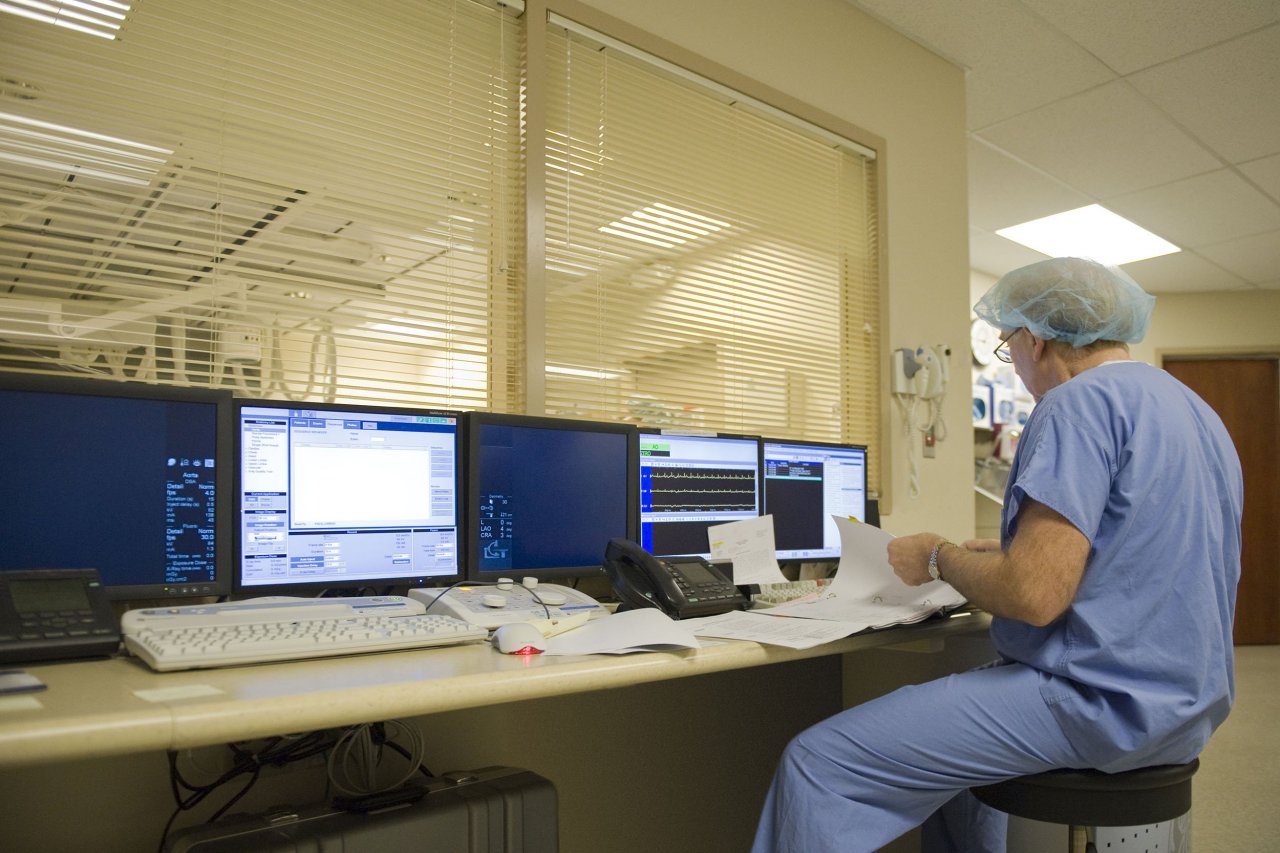After months of delay, the American Board of Internal Medicine (ABIM) finally filed its latest financial reports with the IRS. Which means it's time to return to a fantasyland where up is down, black is white and money is hidden.
It's quite a work of trickery, particularly when it comes to compensation: In the document, the ABIM appears to have begun cutting back its massive pay to top officers, but it hasn't. A big percentage of the group's millions in losses was attributable to cash doled out to one former employee. Plus, if not for the footnotes in other records, the huge financial conflicts of the ABIM's leader, Dr. Rich Baron, would have been kept secret until 2016. Sorry, Rich: I'm disclosing your full pay here. And it's obscene.
But first, a primer for those who haven't kept up on the controversy: The ABIM is a purported nonprofit that certifies new physicians as meeting standards of practice. Beginning in the early 1990s, the ABIM ordered certified doctors to be recertified, again and again. Without the ABIM seal of approval, lots of internists and subspecialists can't get jobs and can't admit patients to hospitals. So by taking advantage of that monopolistic power, the ABIM has forced hundreds of thousands of physicians to follow recertification processes that doctors complain cost them tons of money (paid to the ABIM), require tons of time (taken from families and medical practices) and accomplish nothing.
As a result, doctors and government health specialists say, the ABIM and its related organizations are harming American medicine and diminishing the quality of scientific research, pushing physicians to close practices rather than wasting time on expensive and frustrating busywork, and forcing specialists to play a game of medical trivial pursuit. (Even Baron has admitted that he was tested for recertification on topics he never used in his practice.)
The stories told by doctors who have contacted me about their ABIM experiences are shocking: One who finished all possible requirements and passed every test remains uncertified because the ABIM demanded he perform make-work using records to which his hospital won't allow access; another was forced to learn how to read tissue slides for a procedure he never has and never will perform; physicians who attend "review" courses study proper medical procedures before being coached on the incorrect answers the ABIM tests count as correct; young physicians whose bosses have to teach them diagnostic techniques that no one has employed for years because that useless knowledge is tested on the exams—the list of horrors and absurdities goes on too long to include everything.
Then there are the Cruella de Vil tactics driven by the ABIM's unquenchable thirst for cash: The married physicians who spent thousands of dollars huge sums to take ABIM tests, were forced to miss the exam day when a wife went into labor and were told by the ABIM that their payments couldn't be applied to another test—they had to pay the gargantuan fees all over again or lose their hospital admitting privileges. There are doctors with lifetime certification who have paid bills to the ABIM improperly, and the ABIM refuses to refund their money. And on and on.
Doctors have started publicly slamming the group in industry publications. "ABIM is imposing on us an onerous and ill-conceived tool, one that most physicians agree is irrelevant," Dr. Karmela Chan wrote in Internal Medicine News. "I am glad this conversation is happening, because, frankly, the process was enough to make me want to quit being a doctor."
In a recent poll of 2,211 physicians conducted on a doctors-only website called Sermo, 97 percent of the respondents criticized recertification. Some 56 percent said the ABIM and other recertification boards are more focused on generating revenue for themselves than on educating doctors, while 43 percent said the recertification process was irrelevant to the medicine they practice. Only 3 percent said it was any good.
Meanwhile, the ABIM ignores doctors' pleas to prove its recertification process does anything other than enrich its bureaucrats. In fact, the ABIM has not only refused to produce data showing the program improves patient care but also hasn't conducted any studies on that matter. Doctors often speak in amazement of how a group organized around the idea of improving science refuses to allow independent, comprehensive scientific research to prove its recertification process accomplishes anything. Then again, the ABIM would lose millions if research showed that the product it forces doctors to purchase is bunk.
The explosion of criticism began last year, when the ABIM announced it was going to increase the amount of busywork required for recertification and charge its physicians even more money—something Newsweek previously reported was a dodge intended to disguise years of financial mismanagement and lousy accounting. While the ABIM backed off that effort, a group of physicians—including some of the country's most prominent ones—formed their own recertification program. Organizations that profit from the ABIM monopoly immediately raged against the mutiny, including one that sent letters to doctors declaring that anyone who recertified elsewhere would probably lose malpractice cases.
Many doctors tell me their criticisms of recertification on sites sponsored by the ABIM or related groups are deleted; their tweets demanding change result in their account being blocked; and the "conferences" where the debate is supposed to be aired are rigged to keep prominent critics off panels.
I can attest to the ABIM's pomposity. Starting with my first story about the ABIM, the organization usually has refused to acknowledge I even asked a question. The only other group to do that in my 30-year journalism career was a company that processed payments for child pornography websites. Plus, when I reported on the uprising by doctors, the ABIM ignored the facts and instead investigated me.
What's most troubling about the ABIM using dissent-crushing techniques that would make Lenin proud is the two-faced behavior of the group's leadership—particularly Baron, who demands disclosure of the slightest scintilla of even a theoretical conflict of interest from critics while refusing to fully reveal his own massive financial interest in keeping the recertification train rolling.
Which brings us back to the ABIM's recent IRS filing, a document called a Form 990 that is required from all nonprofits. Once again, the document shows the ABIM is a financial mess. For 2013, it reported total assets of $57 million and liabilities of $105 million, so fund balance (assets minus liabilities) is a negative $48 million. What's bizarre is that Baron publicly crowed that, based on its 990s, The ABIM's assets were three times its liabilities—a patently untrue statement. The ABIM also lost $4.8 million on $55.5 million in revenues, largely attributable to its bloated payroll.
Then come the fun parts. As it has year after year, the ABIM claimed it spent no money on lobbying, its grandest and most easily exposed prevarication. To understand how specific the IRS requirement for disclosure on that topic is, if one ABIM official spent one phone call on, say, a discussion with a lobbyist, the salary expended for that time period would have to be disclosed as a lobbying expense.
However, while the ABIM says it spent nothing on lobbying for the period covered by the new 990, records with the Center of Responsive Politics show it paid $100,000 to lobbyists (that amount climbed to $160,000 in 2014). Much of that money, the records show, went to lobbying Congress on Medicare and Medicaid. And—surprise!—the ABIM and other recertification organizations now have a big role defining ways to improve patient care that, if followed, will partly determine the size of Medicare payments to doctors. And guess what is the only program that any of these organizations deem, based on no data, improves patient care?
The ABIM did finally fix one of the oddities of its 990s that seemed to demonstrate its incompetence. For years, the group incorrectly listed Iowa in response to the question asking for its place of domicile, even though it didn't have a building, an employee or even a phone line in that state. This year, the ABIM's highly paid officials finally figured out that they go to work each day in downtown Philadelphia and reported in the new 990 that their employer is domiciled in Pennsylvania.
Now, as promised, let's look at the compensation of the ABIM's top officers. This is tough to do, because it requires thumbing through many pages in different financial records to dig up the numbers—something that, especially for a nonprofit, should be revealed clearly and simply. I had an easier time figuring out the compensation of officials at Enron, WorldCom and Adelphia—all famous for lying on financial filings—than I did for those at the ABIM, where enormous effort seems to have been taken to make murky what should be crystal clear.
Take former President and CEO Christine Cassel. Page 7 of the just-released 990, under the heading "Compensation of Officers," lists $741,553 paid from the ABIM, $247,184 from the ABIM Foundation (a group that seems to be little more than a compensation slush fund for ABIM officials) and $219,156 in "other" compensation. Grand total: $1,207,893. So most folks could reasonably assume that Cassel received $1,207,893. (It's not clear if she benefited from the ABIM's multimillion-dollar condominium disclosed in the foundation's 990.)
That lofty number understates Cassel's paycheck by 42 percent. The ABIM pays its executives so much money that they seem embarrassed to put it all on Page 7, the usual place nonprofits list compensation. Instead, they shifted more money each year into a deferred compensation pot, which the ABIM treats as an unfunded liability (meaning it isn't socking the cash away). The ABIM finally dumped actual dollars into that pot in 2013, and then handed it to Cassel as she headed out the door.
You can find this on Page 28 of the 990 (be prepared for an aching neck if you look at the numbers on a computer—they're listed sideways). There, it shows Cassel received $504,953 more in deferred compensation, for a grand total of $1,712,846. This is six times the median compensation for nonprofits with revenues between $50 million and $100 million, according to an analysis by Charity Navigator. Remember: The ABIM revenues reported in the new 990 were $55.5 million, meaning it is near the bottom of the 91 nonprofits in that range. (And don't think ABIM's excessive pay is limited to chief executives. Lorie Slass, the spokeswoman who refuses to acknowledge the existence of reporters who ask tough questions about the ABIM, makes $255,000 a year, close to the median pay for someone running a comparable-size nonprofit.)
But what about Baron, who took over Cassel's job and wails about what he proclaims are conflicts for anyone who criticizes his organization? In the latest ABIM 990, Baron comes off as a noble man, one willing to take a huge cut in pay compared with what Cassel banked. His pay from the ABIM is listed everywhere as $273,852, a very reasonable amount for the head of a nonprofit. But this is the ABIM we're talking about, and Baron is raking it in. (I asked that $255,000-a-year spokeswoman, Slass, for Baron's full compensation figure, which is public information that will have to eventually be disclosed since the ABIM isn't paying taxes; as usual, she refused to acknowledge that I had asked the question.)
Here's why people reading the ABIM 990s are more likely to find Jimmy Hoffa than figure out how much Baron is pulling in. Even though almost two years have passed since he took the top job, the new 990 covers only 2013. On the top line of the front page, the document states that the results reported are for the calendar year or the fiscal year. The ABIM puts its fiscal year on that line—July 1, 2013, through June 30, 2014—a 12-month period beginning the day Baron took charge. So unsophisticated readers would assume his reported compensation in that 990 is his annual pay.
Except IRS rules require only that nonprofits report calendar-year compensation. That means, despite the words on the front page, the disclosure in May 2015 shows just what Baron received from July 1, 2013, through December 31, 2013, assuming the ABIM followed the IRS rules.
So double that declared figure, which means Baron's base pay on an annualized was $547,704. At minimum. And that doesn't include his paycheck from the ABIM Foundation, that compensation slush fund that handed him $91,111. And again, double it, because of the fiscal/calendar year mishmash. That brings Baron's annualized income up to $729,926.
And there's more misdirection here. Under his contract reported in the joint 2014 audited financials of the ABIM and the ABIM Foundation (a document the groups fought to keep secret), Baron is contracted to receive "at least" $568,000 per year from the two groups. (And that "at least" has become a dodge to pay him a whole lot more.) This information is reported in a footnote without stating Baron's name as the recipient of this largesse, so it's easy to miss.
On top of that, Baron gets annual incentive bonuses. Such bonuses are usually paid every year on the date of employment, which is why the ABIM and the ABIM Foundation report that Baron received nothing as an annual bonus—the group cut the check for Baron after the 990 reporting period ended. As usual, the ABIM ignored me when I asked what his bonus was.
Not done yet. Just as they did for Cassel, the ABIM and the ABIM Foundation are piling up deferred compensation for Baron. Yet that appears nowhere in the 990s of either organization, which specifically state that Baron received nothing in deferred compensation. How did they do the dodge? Based on the audited financials, the two groups set up Baron's deferred honeypot in June 2013 (during the time covered by the 990s), and then assumed the year's entire liability on June 30, 2014. In other words, once again they have dumped more compensation as an unfunded liability and will pour in the cash when Baron leaves the organization. The total amount of this pay is $131,000, more than Cassel received on an annual basis.
Now, both the bonuses and the deferred compensation were paid about a year ago, past the 990 reporting period. That means it won't be disclosed until 2016—three years into Baron's contract, two years before its expiration, and the first time anyone can know exactly out how much cash the ABIM is dumping into his pockets.
So adding up Baron's pay, he receives $860,926 on an annualized basis. This is three times the median amount paid to the chief executives of the 91 nonprofits with revenues of $50 million to $100 million.
The fact that I can piece together this portion of Baron's pay comes despite the ABIM's efforts to stop anyone from finding out. None of this analysis could be done without the audited financials of the ABIM and the ABIM Foundation, documents the groups worked hard to keep under wraps. First, emails show it refused to turn over the audited financials when the media requested them last year. Then, when the ABIM discovered that someone got their hands on the hard-to-obtain records from Pennsylvania government officials, the group posted a partial copy of the document, leaving out the compensation information. Eventually, an accountant named Charles Kroll posted the full financials online, and the ABIM was finally shamed into releasing the whole thing, including information about compensation and contracts. Nothing is illegal in all of the ABIM's shenanigans and obfuscations, but they sure raise questions about the integrity of the groups.
Why should Americans care that a nonprofit is showering millions on its leaders? As Baron has been quick to point out about ABIM critics, conflicts of interest matter. (After the ABIM investigated me, he attacked me publicly for not revealing the "conflict" that I am married to a doctor, thus suggesting that anyone connected to physicians would automatically oppose the ABIM.)
Yet, despite his pretense of objectivity, he and the ABIM refuse to disclose that he has close to one million reasons to ignore the many doctors who say the recertification process is damaging their practices and taking up so much time that they aren't able to pursue education programs that might actually improve the care they provide.
This might not be so bad if the ABIM didn't have a stranglehold on the nation's internists, leaving them no choice but to cough up large amounts of cash for a product they don't want or need.
The ABIM is a monopoly that can do whatever it wants. Its officers and other officials suckling off the recertification teat are conflicted beyond repair—when their personal wealth is at stake, they cannot possibly be expected to objectively assess a process that thousands of doctors say is harming patient care and that the National Institutes of Health says is damaging science.
It is time for Congress to investigate the ABIM and force these millionaires to prove they aren't damaging America's health care system for personal profit. It is time for the Federal Trade Commission and the Justice Department to investigate whether the ABIM is engaged in a restraint of trade by driving doctors out of business if they don't pay up. It is time for the IRS to investigate whether the ABIM is a nonprofit or a business.
Most important, it is time for doctors to grow a backbone: Organize yourselves and boycott the recertification process en masse. Then maybe Rich Baron and his fellow rich barons at the ABIM will be forced to change the system into something that demonstrably improves patient care rather than just growing the size of their bank accounts.




















